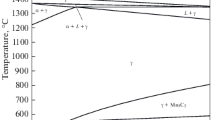Abstract
The works on the structure and mechanical properties of aluminum-alloyed austenitic steels are analyzed. Aluminum in aging high-nitrogen Cr–Mn–Ni–V nonmagnetic steels is shown to decrease the strength due to a decrease in the amount of dispersed VN nitrides having precipitated during aging because of the formation of coarse AlN particles hard to dissolve on quenching heating. An additional increase in the strength of aging nonmagnetic Mn–Ni–V–C steels is reached by their alloying with aluminum, which does not form hard to dissolve compounds with carbon. A significant increase in the surface hardness and the wear resistance during nitriding is reached as a result of separate or complex alloying of Mn–Ni–V steels with chromium up to 3% and aluminum up to 1.2%, which increase the nitrided layer thickness. The best combination of the properties of the nitrided layer is achieved after nitriding these steels containing 2.5–3.5% V at 700°C (12 h) in a 80% N2 + 20% HN3 medium. In this case, the hardening of the core during aging is related to the precipitation of VC carbides, and that of the nitrided layer, to the formation of VN nitrides. A significant increase in the volume fraction of strengthening phases in manganese steels is reached by complex alloying with Al, Ni, Cu, and V in the amounts that provide the simultaneous precipitation of the VC carbide and NiAl intermetallics during aging. Nonmagnetic 50G17N10Yu4F2 steel with a combined carbide–intermetallic hardening is highly competitive in strength (σu > 1600 MPa, σ0.2 > 1400 MPa) with high-strength 18Kh2N4VA ferromagnetic steels and significantly surpasses the well-known aging nonmagnetic high-nitrogen alloys.






Similar content being viewed by others
Notes
From here on, the element content is given in wt %.
REFERENCES
S. L. Case and K. R. Van Horn, Aluminum in Iron and Steel (Chapman & Hall for the Engineering Foundation, New York, 1953).
E. Gudremon, Special Steels (Metallurgiya, Moscow, 1966), Vol. 2, pp. 1027–1045.
M. V. Pridantsev, N. P. Talov, and F. L. Levin, High-Strength Austenitic Steels (Metallurgiya, Moscow, 1969).
O. A. Bannykh, Yu. K. Konveristyi, I. F. Zudin, and D. A. Prokoshkin, “Influence of carbon and aluminum on the properties of steel with 10% Cr and 13% Mn at elevated temperatures. The study on high-temperature alloys,” Trudy Akad. Nauk SSSR VII, 319 (1961).
O. A. Bannykh and I. F. Zudin, “Several Properties of iron–aluminum alloys based on an α-solid solution,” Doklady Akad. Nauk SSSR, No. 5 (1960).
O. A. Bannykh and I. F. Zudin, Phase Composition and Properties of Cr–Mn–Al Steel. Study of Steels and Alloys (Nauka, Moscow, 1964).
O. A. Bannykh, Yu. K. Kovneristyi, and I. F. Zudin, Chromium–Manganese Heat Resistant Steels with Aluminum (Nauka, Moscow, 1965).
L. Mosecer and A. Saeed-Akbari, “Nitrogen in chromium–manganese stainless steel: a review on the evolution of stacking fault energy by computational thermodynamics,” Sci. Technol. Adv. Mater. 14, 1–14 (2013).
Yu. N. Petrov, “On the electron structure of Mn, Ni, and Cr–Ni–Mn austenite with different stacking fault energy,” Scr. Mater. 53, 1201–1206 (2005).
V. G. Gavriyuk, Yu. N Petrov, and V. D. Shanina, “Effect of nitrogen o the electron structure and stacking fault energy in austenitic steels,” Scr. Mater. 55, 537–540 (2005).
O. A. Bannykh, “Principles of alloying chromium–manganese austenitc steels for operating at elevated temperatures,” Metalloved. Term. Obrab. Met., No. 7, 7–10 (1980).
V. M. Blinov, M. V. Kostina, E. V. Blinov, and M. S. Khadyev, “Structure and properties of high-temperature austenitic low-carbon 01Kh15N22AG2V4TYu and 02Kh18N12AG11MFB steels,” Russ. Met. (Metally), no. 9, 798–812 (2011).
V. M. Blinov, I. O. Bannykh, and T. N. Zvereva, “High-plasticity heat-resistant 03Kh14G16N6Yu-type steel with heat- and deformation-resistant austenite,” Russ. Met. (Metally), no. 4, 329–335 (2008).
O. A. Bannykh and V. M. Blinov, Precipitation Hardening Nonmagnetic Vanadium-Containing Steels (Nauka, Moscow, 1980).
Yu. M. Lakhtin and V. M. Blinov, Effect of Alloying and Baropolygonization on the Structure and Properties of a Nitrided Layer of Precipitation Hardening Nonmagnetic Steels (Nauka, Moscow, 1978), pp. 131–139.
Yu. M. Lakhtin, T. M. Borovskaya, and V. M. Blinov, “Nitriding of precipitation hardening nonmagnetic steels,” in New Materials in Mechanical Engineering (NIIinformTYAZHMASH, 1977), Vol. 14-77-16, pp. 9–14.
O. A. Bannykh, V. M. Blinov, and G. M. Mankina, “Carbide–intermetallic hardening of nonmagnetic steels,” Metalloved. Term. Obrab. Met., No. 6, 12–16 (1978).
V. M. Blinov, O. A. Bannykh, and G. M. Mankina, “Microstructure, phase composition, and mechanical properties of aging nonmagnetic steels with carbide–intermetallic (VC + NiAl) hardening,” Izv. Akad. Nauk SSSR, Ser. Met., no. 4, 168–176 (1978).
Funding
This work was performed in the framework of state task no. 076-00328-21-00 of the Ministry of Education and Science of the Russian Federation.
Author information
Authors and Affiliations
Corresponding author
Additional information
Translated by Yu. Ryzhkov
Rights and permissions
About this article
Cite this article
Blinov, V.M., Bannykh, I.O., Lukin, E.I. et al. Effect of Aluminum on the Structure and Mechanical Properties of Austenitic Steels. Russ. Metall. 2021, 1093–1101 (2021). https://doi.org/10.1134/S0036029521090044
Received:
Revised:
Accepted:
Published:
Issue Date:
DOI: https://doi.org/10.1134/S0036029521090044




